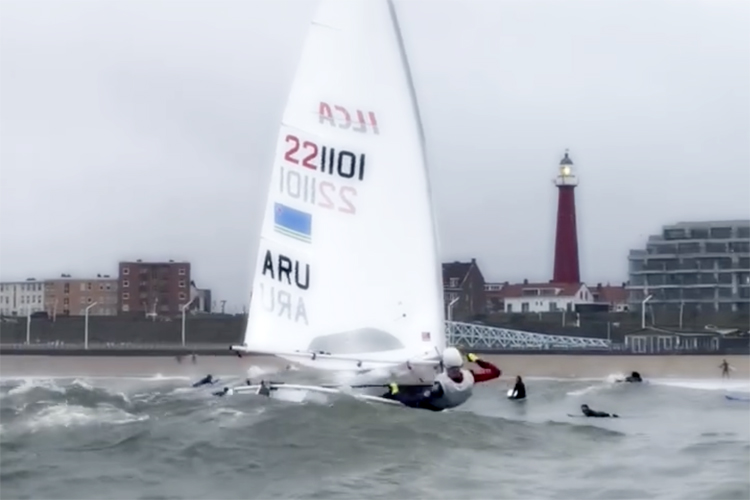How to ride a wave on a Laser sailboat without capsizing

There are many ways to ride a wave using surprisingly more surf craft than one could imagine. But can the Laser Olympic sailboat do it?
We’ve seen people taking on swells with the most unusual and unexpected types of wave-riding vehicles: doors, tables, wooden planks, ice sheets, ironing boards, and even televisions.
However, catching waves with sailboats is a different league.
Sailing boats are heavy and harder to steer and control than a standard surfboard. Obviously, right?
It depends.
The World’s Most Popular One-Design Sailboat
Take the famous single-handed, one-design Laser, also known as the ILCA dinghy.
The boat weighs approximately 59 kilograms (130 pounds). The hull is 4.23 meters (13.875 feet) in length, with a beam (width) of 1.42 meters (4.658 feet).
It is equipped with a daggerboard and a kick-up rudder, allowing for efficient sailing in various wind conditions.
The standard rig has a sail area of approximately 7.06 square meters (76 square feet).
While sailing the Laser, there are a lot of things to do simultaneously.
The Laser sailboat was designed in 1969 by Canadian Bruce Kirby and American industrial designer Ian Bruce.
Initially conceived as a simple boat that could be carried on a car roof, it quickly became popular due to its straightforward design, affordability, and ease of use.
The prototype, initially called the “Weekender,” was later renamed the “Laser,” reflecting its sleek and fast design.
The International Laser Class Association (ILCA) gained significant recognition when it was selected as an Olympic class in 1996, further solidifying its status in competitive sailing.
The Laser is one of the most popular single-handed dinghies in the world, with over 215,000 boats built.
It has active fleets in many countries and is sailed by people of all ages.
Laser Surfing
One thing is riding a Laser sailboat in unbroken swells in an open ocean.
Another thing is taking this dinghy along with the mast and sail into near-shore surf breaks in six-foot conditions and share the lineup with shortboard surfers.
Two Olympic ILCA sailors have done it with impressive results.
One of them is Aruban Laser specialist, who published a compilation of his wave-riding skills at Scheveningen, Netherlands, and Islote the Lobos, Canary Islands.
It’s impressive how this Olympic sailor manages to keep his boat on an optimal surf line without capsizing or digging the bow underwater.
Then, there’s the infamous video featuring Brazilian sailor Mateus Tavares taking on overhead waves at Farol da Barra near Salvador da Bahia, Brazil.
Tavares casually sails over incoming swells before turning around and dropping into the critical section, where the wave crests start to crumble.
Imagine a point break for dinghies. And now, imagine filling a sail with wind instead of arm power to propel you into a wave.
It takes skills and a lot of confidence.
Words by Luís MP | Founder of SurferToday.com



